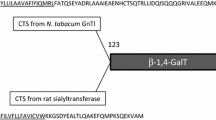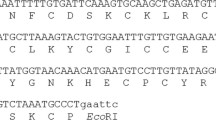Abstract
We have constructed a filamentous fungus Aspergillus oryzae that secretes a llama variable heavy-chain antibody fragment (VHH) that binds specifically to epidermal growth factor receptor (EGFR) in a culture medium. A major improvement in yield was achieved by fusing the VHH with a Taka-amylase A signal sequence (sTAA) and a segment of 28 amino acids from the N-terminal region of Rhizopus oryzae lipase (N28). The yields of secreted, immunologically active anti-EGFR VHH reached 73.8 mg/1 in a Sakaguchi flask. The VHH fragments were released from the sTAA or N28 proteins by an indigenous A. oryzae protease during cultivation. The purified recombinant VHH fragment was specifically recognized and could bind to the EGFR with a high affinity.






Similar content being viewed by others
References
Adachi T, Ito J, Kawata K, Kaya M, Ishida H, Sahara H, Hata Y, Ogino C, Fukuda H, Kondo A (2008) Construction of an Aspergillus oryzae cell-surface display system using a putative GPI-anchored protein. Appl Microbiol Biotechnol 81:711–719
Barbesgaard P, Heldt-Hansen HP, Diderichsen B (1992) On the safety of Aspergillus oryzae: a review. Appl Microbiol Biotechnol 36:569–572
Bradford MM (1976) A rapid and sensitive method for the quantitation of microgram quantities of protein utilizing the principle of protein-dye binding. Anal Biochem 72:248–254
Carrez D, Janssens W, Degrave P, van den Hondel CA, Kinghorn JR, Fiers W, Contreras R (1990) Heterologous gene expression by filamentous fungi: secretion of human interleukin-6 by Aspergillus nidulans. Gene 94:147–154
Desmyter A, Decanniere K, Muyldermans S, Wyns L (2001) Antigen specificity and high affinity binding provided by one single loop of a camel single-domain antibody. J Biol Chem 276:26285–26290
Dumoulin M, Conrath K, Van Meirhaeghe A, Meersman F, Heremans K, Frenken LG, Muyldermans S, Wyns L, Matagne A (2002) Single-domain antibody fragments with high conformational stability. Protein Sci 11:500–515
Frenken LGJ, Hessing JGM, Van den Hondel CAMJJ, Verrips CT (1998) Recent advances in the large-scale production of antibody fragments using lower eukaryotic microorganisms. Res Immunol 149:589–599
Frenken LG, van der Linden RH, Hermans PW, Bos JW, Ruuls RC, de Geus B, Verrips CT (2000) Isolation of antigen specific llama VHH antibody fragments and their high level secretion by Saccharomyces cerevisiae. J Biotechnol 78:11–21
Giard DJ, Aaronson SA, Todaro GJ, Arnstein P, Kersey JH, Dosik H, Parks WP (1973) In vitro cultivation of human tumors: establishment of cell lines derived from a series of solid tumors. J Natl Cancer Inst 51:1417–1423
Gomi K, Iimura Y, Hara S (1987) Integrative Transformation of Aspergillus-Oryzae with a Plasmid Containing the Aspergillus-Nidulans-Argb Gene. Agric Biol Chem 51:2549–2555
Hama S, Tamalampudi S, Fukumizu T, Miura K, Yamaji H, Kondo A, Fukuda H (2006) Lipase localization in Rhizopus oryzae cells immobilized within biomass support particles for use as whole-cell biocatalysts in biodiesel-fuel production. J Biosci Bioeng 101:328–333
Hama S, Tamalampudi S, Shindo N, Numata T, Yamaji H, Fukuda H, Kondo A (2008) Role of N-terminal 28-amino-acid region of Rhizopus oryzae lipase in directing proteins to secretory pathway of Aspergillus oryzae. Appl Microbiol Biotechnol 79:1009–1018
Hamers-Casterman C, Atarhouch T, Muyldermans S, Robinson G, Hamers C, Songa EB, Bendahman N, Hamers R (1993) Naturally occurring antibodies devoid of light chains. Nature 363:446–448
Harmsen MM, De Haard HJ (2007) Properties, production, and applications of camelid single-domain antibody fragments. Appl Microbiol Biotechnol 77:13–22
Hisada H, Sano M, Ishida H, Hata Y, Abe Y, Machida M (2006) Deletion analysis of the superoxide dismutase (sodM) promoter from Aspergillus oryzae. Appl Microbiol Biotechnol 72:1048–1053
Ishida H, Hata Y, Kawato A, Abe Y, Kashiwagi Y (2004) Isolation of a novel promoter for efficient protein production in Aspergillus oryzae. Biosci Biotechnol Biochem 68:1849–1857
Joosten V, Lokman C, Van Den Hondel CA, Punt PJ (2003) The production of antibody fragments and antibody fusion proteins by yeasts and filamentous fungi. Microb Cell Factories 2:1
Joosten V, Gouka RJ, van den Hondel CA, Verrips CT, Lokman BC (2005a) Expression and production of llama variable heavy-chain antibody fragments (V(HH)s) by Aspergillus awamori. Appl Microbiol Biotechnol 66:384–392
Joosten V, Roelofs MS, van den Dries N, Goosen T, Verrips CT, van den Hondel CA, Lokman BC (2005b) Production of bifunctional proteins by Aspergillus awamori: llama variable heavy chain antibody fragment (V(HH)) R9 coupled to Arthromyces ramosus peroxidase (ARP). J Biotechnol 120:347–359
Kitamoto K (2002) Molecular biology of the Koji molds. Adv Appl Microbiol 51:129–153
Laemmli UK (1970) Cleavage of structural proteins during the assembly of the head of bacteriophage T4. Nature 227:680–685
Matsui K, Karasaki M, Segawa M, Hwang SY, Tanaka T, Ogino C, Kondo A (2010) Biofunctional TiO(2) nanoparticle-mediated photokilling of cancer cells using UV irradiation. Medchemcomm 1:209–211
Muyldermans S (2001) Single domain camel antibodies: current status. J Biotechnol 74:277–302
Pace CN, Vajdos F, Fee L, Grimsley G, Gray T (1995) How to measure and predict the molar absorption coefficient of a protein. Protein Sci 4:2411–2423
Porter P, Coley J, Gani M (1988) Immunochemical criteria for successful matching of monoclonal antibodies to immunoassays of peptide hormones for assessment of pregnancy and ovulation. Prog Clin Biol Res 285:181–200
Roovers RC, Laeremans T, Huang L, De Taeye S, Verkleij AJ, Revets H, de Haard HJ, van Bergen en Henegouwen PM (2007) Efficient inhibition of EGFR signaling and of tumour growth by antagonistic anti-EFGR nanobodies. Cancer Immunol Immunother 56:303–317
Schindler T, Herrler M, Marahiel MA, Schmid FX (1995) Extremely rapid protein-folding in the absence of intermediates. Nat Struct Biol 2:663–673
Tada S, Iimura Y, Gomi K, Takahashi K, Hara S, Yoshizawa K (1989) Cloning and nucleotide-sequence of the genomic Taka-amylase-a gene of Aspergillus-oryzae. Agric Biol Chem 53:593–599
Thomassen YE, Verkleij AJ, Boonstra J, Verrips CT (2005) Specific production rate of VHH antibody fragments by Saccharomyces cerevisiae is correlated with growth rate, independent of nutrient limitation. J Biotechnol 118:270–277
Tsuchiya K, Tada S, Gomi K, Kitamoto K, Kumagai C, Jigami Y, Tamura G (1992) High level expression of the synthetic human lysozyme gene in Aspergillus oryzae. Appl Microbiol Biotechnol 38:109–114
Tsuchiya K, Gomi K, Kitamoto K, Kumagai C, Tamura G (1993) Secretion of calf chymosin from the filamentous fungus Aspergillus oryzae. Appl Microbiol Biotechnol 40:327–332
Tsuchiya K, Nagashima T, Yamamoto Y, Gomi K, Kitamoto K, Kumagai C, Tamura G (1994) High level secretion of calf chymosin using a glucoamylase-prochymosin fusion gene in Aspergillus oryzae. Biosci Biotechnol Biochem 58:895–899
Tsukagoshi N, Furukawa M, Nagaba H, Kirita N, Tsuboi A, Udaka S (1989) Isolation of a cDNA encoding Aspergillus oryzae Taka-amylase A: evidence for multiple related genes. Gene 84:319–327
van der Vaart JM (2002) Expression of VHH antibody fragments in Saccharomyces cerevisiae. Methods Mol Biol 178:359–366
van Gemeren IA, Beijersbergen A, Musters W, Gouka RJ, van den Hondel CA, Verrips CT (1996) The effect of pre- and pro-sequences and multicopy integration on heterologous expression of the Fusarium solani pisi cutinase gene in Aspergillus awamori. Appl Microbiol Biotechnol 45:755–763
von Mehren M, Weiner LM (1996) Monoclonal antibody-based therapy. Curr Opin Oncol 8:493–498
Ward PP, Lo JY, Duke M, May GS, Headon DR, Conneely OM (1992) Production of biologically active recombinant human lactoferrin in Aspergillus oryzae. Biotechnology (NY) 10:784–789
Acknowledgments
The A. oryzae niaD mutant (strain IF4) was kindly provided by Research Institute, Gekkeikan Sake Co., Kyoto, Japan. Nanami Nakashima is thanked for technical support and useful discussion. Sachiko Nakamura-Tsuruta and Tomokazu Amino are thanked for binding kinetics analysis by surface plasmon resonance. Satoshi Kawamoto, Research Center for Environmental Genomics, Kobe University, is thanked for protein sequencing analysis. This work was partially supported by Special Coordination Funds for Promoting Science and Technology, Creation of Innovation Centers for Advanced Interdisciplinary Research Areas (Innovative Bioproduction, Kobe), Ministry of Education, Culture, Sports, Science and Technology, Japan.
Author information
Authors and Affiliations
Corresponding author
Additional information
Fumiyoshi Okazaki and Jun-ichi Aoki contributed equally to this work.
Rights and permissions
About this article
Cite this article
Okazaki, F., Aoki, Ji., Tabuchi, S. et al. Efficient heterologous expression and secretion in Aspergillus oryzae of a llama variable heavy-chain antibody fragment VHH against EGFR. Appl Microbiol Biotechnol 96, 81–88 (2012). https://doi.org/10.1007/s00253-012-4158-1
Received:
Revised:
Accepted:
Published:
Issue Date:
DOI: https://doi.org/10.1007/s00253-012-4158-1




